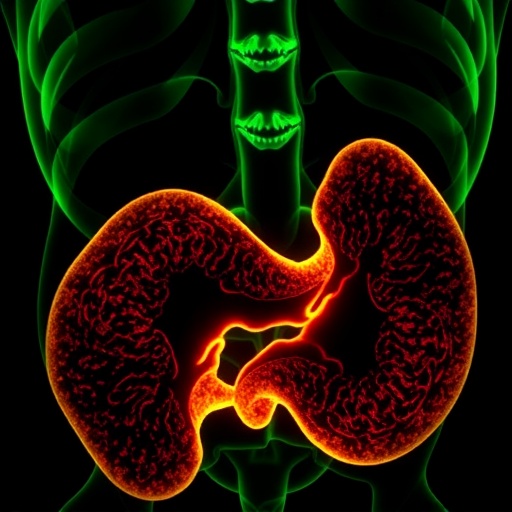In a groundbreaking study published in the Journal of Translational Medicine, researchers have illuminated the roles of pleiotrophin, a heparin-binding growth factor, in the context of the pathological changes occurring within hyperplastic prostate tissue. Prostate enlargement, or benign prostatic hyperplasia (BPH), is a prevalent condition that afflicts a significant proportion of aging men, resulting in various urinary symptoms and diminished quality of life. Despite the widespread occurrence of this condition, the underlying cellular mechanisms remain insufficiently understood, and here, pleiotrophin emerges as a pivotal player.
The research team, led by Dr. Jiang Liu from a prestigious biomedical institution, embarked on a meticulous investigation into pleiotrophin’s effects on cell proliferation and smooth muscle contraction in the prostate. This inquiry was spurred by previous findings that suggested a correlation between pleiotrophin levels and various malignancies, raising questions about its potential involvement in non-cancerous conditions as well. BPH often arises from dysregulated growth in prostate epithelial and stromal cells, thus understanding the modulatory effects of pleiotrophin could pave the way for novel therapeutic strategies.
Through a series of in vitro experiments and in vivo models, the researchers quantitatively assessed the impact of pleiotrophin on cell proliferation rates. The findings were compelling, revealing that higher concentrations of pleiotrophin significantly accelerated the proliferation of prostatic stromal cells. The implications of this acceleration are profound, as increased cell proliferation is a hallmark of hyperplastic conditions. The complexity of cellular pathways influenced by pleiotrophin involves various signaling cascades, including the MAPK/ERK pathway, which are known to regulate cellular growth and differentiation.
Moreover, the study meticulously documented pleiotrophin’s role in modulating smooth muscle contraction—a critical factor in BPH that contributes to urinary obstruction. The team utilized isolated smooth muscle strips from hyperplastic prostate tissue to evaluate the contractile response driven by pleiotrophin. Results indicated that the application of pleiotrophin resulted in a notable increase in contractile activity. These findings underscore the notion that pleiotrophin not only enhances cell proliferation but also actively influences the functional characteristics of smooth muscle within the prostate, thereby contributing to the overall symptomatology of BPH.
Fibrosis is another central feature observed in BPH that exacerbates functional impairment. In examining the fibrogenic properties of pleiotrophin, the researchers discovered its ability to stimulate fibroblast activation and subsequent extracellular matrix production. This aberrant accumulation of fibrous tissue can lead to structural changes in the prostate, further worsening urinary symptoms. Investigating this relationship, the researchers applied various inhibitors to dissect the molecular mechanisms underpinning pleiotrophin’s fibrogenic effects and discovered a nexus between pleiotrophin signaling and transforming growth factor-beta (TGF-β) pathways, which are quintessential in fibrosis development.
The research may hold significant implications, particularly in the context of developing targeted pharmacological interventions aimed at mitigating the effects of BPH. With increasing public health awareness regarding prostate health, these findings provide new avenues for potential therapeutic exploration. Targeting the pathways related to pleiotrophin’s role could lead to novel approaches in preventing or reversing hyperplastic changes within the prostate. Importantly, drug repurposing efforts may also benefit from insights gained about pleiotrophin, opening doors for innovative treatment options that are both effective and safe.
Considering the clinical repercussions of these findings, it is crucial to translate laboratory insights into real-world applications. While the study provides foundational knowledge regarding pleiotrophin’s involvement in cell proliferation, smooth muscle contraction, and fibrosis within the hyperplastic prostate, further clinical trials are necessary to evaluate the therapeutic potential of targeting pleiotrophin-related pathways. The aim is to thoroughly understand how altering pleiotrophin signaling may ameliorate the symptoms of BPH and improve patient outcomes.
The study also ignites a conversation about the broader implications of growth factors like pleiotrophin beyond prostate health. The insights gained may extend to other organ systems where similar pathophysiological processes occur. For instance, exploring pleiotrophin’s roles in conditions characterized by abnormal cell growth or fibrogenesis could enrich the scientific discourse and open new paradigms for treatment across various medical specialties.
As a result, this research not only deepens our understanding of BPH but also exemplifies how fundamental research can lead to impactful clinical advancements. The potential for a transformative therapeutic landscape in the management of benign prostatic hyperplasia is vast, and future investigations spurred by these findings will undoubtedly focus on delineating the precise pathways involved while assessing safety and efficacy in human trials.
In conclusion, the findings related to pleiotrophin’s multifaceted roles in the hyperplastic prostate represent a significant advancement in our understanding of this common urological condition. The interplay between cell proliferation, smooth muscle contraction, and fibrosis elucidated in this study provides a compelling rationale for continued research. By continuing to explore this growth factor’s therapeutic potential, we may soon be on the brink of novel interventions to enhance the quality of life for millions of men affected by BPH.
This investigative work serves as a testament to the intricate complexities of growth factors within human health and disease, reiterating the need for a nuanced understanding of how biological processes intersect to inform the development of effective medical therapies. The journey of discovery in this field continues, with a hopeful eye toward the future of patient’s health and well-being.
The multifaceted nature of pleiotrophin’s roles highlights not only the complexity of prostate biology but also the intricate balance required in maintaining organ function. The landscape of prostate health is set to transform as ongoing research sheds light on the precise mechanisms through which pleiotrophin and related pathways influence health, disease, and potential treatment modalities.
Subject of Research: Pleiotrophin’s impact on prostate smooth muscle contraction, cell proliferation, and fibrosis in benign prostatic hyperplasia (BPH).
Article Title: Pleiotrophin modulates cell proliferation, prostate smooth muscle contraction and fibrosis in hyperplastic prostate.
Article References:
Liu, J., Fan, J., Liu, H. et al. Pleiotrophin modulates cell proliferation, prostate smooth muscle contraction and fibrosis in hyperplastic prostate.
J Transl Med 23, 1128 (2025). https://doi.org/10.1186/s12967-025-07172-0
Image Credits: AI Generated
DOI: 10.1186/s12967-025-07172-0
Keywords: Pleiotrophin, prostate health, benign prostatic hyperplasia, fibrosis, cell proliferation, smooth muscle contraction, therapeutic interventions.




